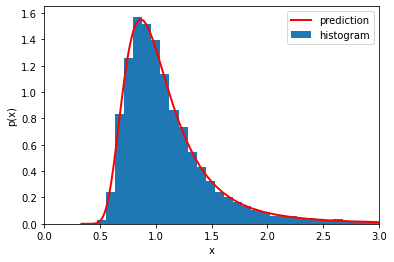Change of variables with autodiff¶
In this notebook we will be predicting the distribution of \(q=1/x\) when \(x\sim N(\mu,\sigma)\) with automatic differentiation. This is a follow up to the previous notebook How do distributions transform under a change of variables ?, which did not use autodiff.
by Kyle Cranmer, March 2, 2020
import numpy as np
import scipy.stats as scs
import matplotlib.pyplot as plt
mean=1.
std = .3
N = 10000
x = np.random.normal(mean, std, N)
x_plot = np.linspace(0.1,3,100)
_ = plt.hist(x, bins=50, density=True)
plt.plot(x_plot, scs.norm.pdf(x_plot, mean, std), c='r', lw=2)
[<matplotlib.lines.Line2D at 0x7ff680312520>]
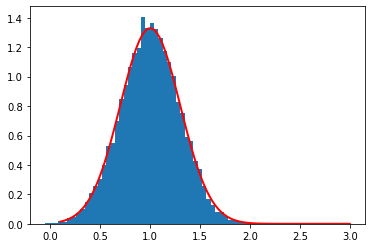
def q(x):
return 1/x
q_ = q(x)
q_plot = q(x_plot)
plt.plot(x_plot, q_plot,label='q(x)')
_ = plt.hist(x, bins=50, density=True, label='p(x)')
plt.xlabel('x')
plt.ylabel('q or p(q)')
plt.legend()
<matplotlib.legend.Legend at 0x7ff67055ef40>
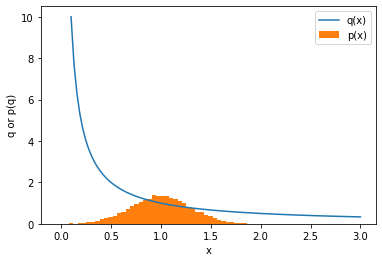
mybins = np.linspace(0,3,50)
_ = plt.hist(q_, bins=mybins, density=True)
plt.xlabel('x')
plt.ylabel('p(x)')
Text(0, 0.5, 'p(x)')
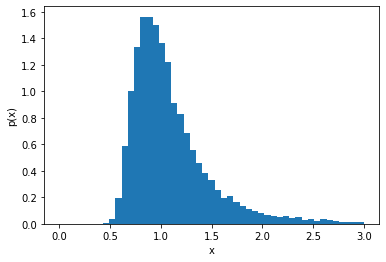
Do it by hand¶
We want to evaluate \(p_q(q) = \frac{p_x(x(q))}{ | dq/dx |} \), which requires knowing the deriviative and how to invert from \(q \to x\). The inversion is easy, it’s just \(x(q)=1/q\). The derivative is \(dq/dx = \frac{-1}{x^2}\), which in terms of \(q\) is \(dq/dx = q^2\).
_ = plt.hist(q_, bins=mybins, density=True, label='histogram')
plt.plot(q_plot, scs.norm.pdf(1/q_plot, mean, std)/q_plot/q_plot, c='r', lw=2, label='prediction')
plt.xlim((0,3))
plt.xlabel('x')
plt.ylabel('p(x)')
plt.legend()
<matplotlib.legend.Legend at 0x7ff660a8df40>
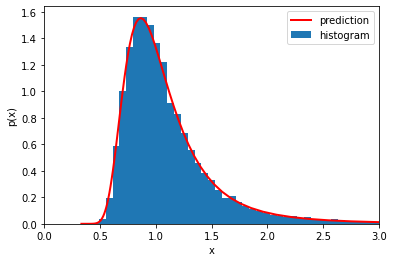
Alternatively, we don’t need to know how to invert \(x(q)\). Instead, we can start with x_plot and use the evaluated pairs (x_plot, q_plot=q(x_plot)). Then we can just use x_plot when we want \(x(q)\).
Here is a plot of the inverse mad ethat way.
plt.plot(q_plot, x_plot, c='r', lw=2, label='inverse x(q)')
plt.xlim((0,3))
plt.xlabel('q')
plt.ylabel('x(q)')
plt.legend()
<matplotlib.legend.Legend at 0x7ff680305bb0>
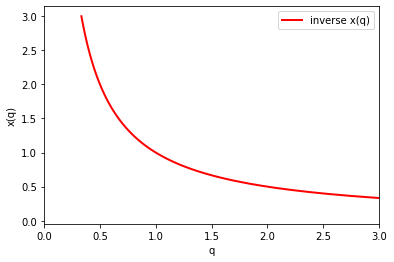
and here is a plot of our prediction using x_plot directly
_ = plt.hist(q_, bins=mybins, density=True, label='histogram')
plt.plot(q_plot, scs.norm.pdf(x_plot, mean, std)/np.power(x_plot,-2), c='r', lw=2, label='prediction')
plt.xlim((0,3))
plt.xlabel('x')
plt.ylabel('p(x)')
plt.legend()
<matplotlib.legend.Legend at 0x7ff6803ef100>
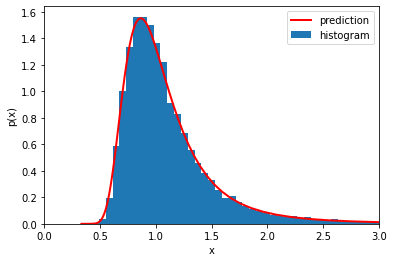
With Jax Autodiff for the derivatives¶
Now let’s do the same thing using Jax to calculate the derivatives. We will make a new function dq by applying the grad function of Jax to our own function q (eg. dq = grad(q)).
from jax import grad, vmap
import jax.numpy as np
#define the gradient with grad(q)
dq = grad(q) #dq is a new python function
print(dq(.5)) # should be -4
-4.0
/Users/cranmer/anaconda3/envs/stat-ds-book/lib/python3.8/site-packages/jax/lib/xla_bridge.py:130: UserWarning: No GPU/TPU found, falling back to CPU.
warnings.warn('No GPU/TPU found, falling back to CPU.')
# dq(x) #broadcasting won't work. Gives error:
# Gradient only defined for scalar-output functions. Output had shape: (10000,).
#define the gradient with grad(q) that works with broadcasting
dq = vmap(grad(q))
#print dq/dx for x=0.5, 1, 2
# it should be -1/x^2 =. -4, 1, -0.25
dq( np.array([.5, 1, 2.]))
DeviceArray([-4. , -1. , -0.25], dtype=float32)
#plot gradient
plt.plot(x_plot, -np.power(x_plot,-2), c='black', lw=2, label='-1/x^2')
plt.plot(x_plot, dq(x_plot), c='r', lw=2, ls='dashed', label='dq/dx from jax')
plt.xlabel('x')
plt.ylabel('dq/dx')
plt.legend()
<matplotlib.legend.Legend at 0x7ff690d4ef10>
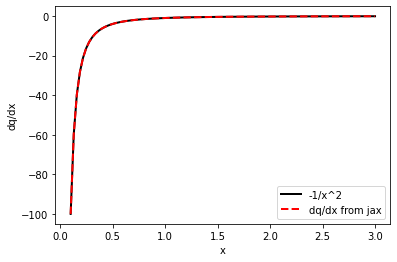
We want to evaluate
\(p_q(q) = \frac{p_x(x(q))}{ | dq/dx |} \),
which requires knowing how to invert from \(q \to x\). That’s easy, it’s just \(x(q)=1/q\). But we also have evaluated pairs (x_plot, q_plot), so we can just use x_plot when we want \(x(q)\)
Put it all together.
Again we can either invert x(q) by hand and use Jax for derivative:
_ = plt.hist(q_, bins=np.linspace(-1,3,50), density=True, label='histogram')
plt.plot(q_plot, scs.norm.pdf(1/q_plot, mean, std)/np.abs(dq(1/q_plot)), c='r', lw=2, label='prediction')
plt.xlim((0,3))
plt.xlabel('x')
plt.ylabel('p(x)')
plt.legend()
<matplotlib.legend.Legend at 0x7ff65906a460>
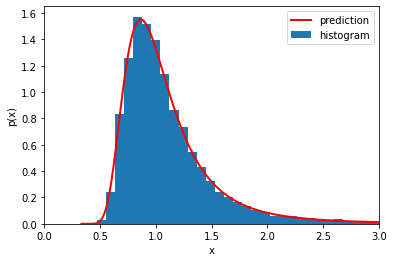
or we can use the pairs x_plot, q_plot
_ = plt.hist(q_, bins=np.linspace(-1,3,50), density=True, label='histogram')
plt.plot(q_plot, scs.norm.pdf(x_plot, mean, std)/np.abs(dq(x_plot)), c='r', lw=2, label='prediction')
plt.xlim((0,3))
plt.xlabel('x')
plt.ylabel('p(x)')
plt.legend()
<matplotlib.legend.Legend at 0x7ff6707ea0a0>
